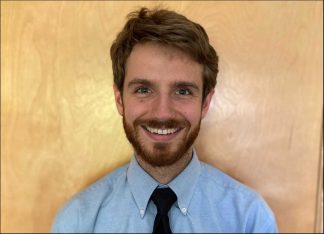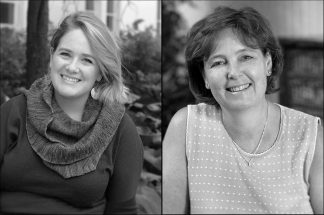By Allison Campbell-Jensen
Perhaps it was the surgical connection that brought John Cole to the Wangensteen Historical Library of Biology and Medicine? After all, he is working in the Department of Surgery’s Visible Heart Lab as a librarian, and Dr. Owen Wangensteen, who served as chair of surgery from 1930 until 1967, founded the collection.
But Cole, who also is a library student in SUNY-Buffalo’s online program, credits serendipity. Whatever the cause, the results have been a valuable 3D scanning experience for Cole, a useful protocol for the Wangensteen Library, and something more.
Becoming acquainted
Cole “ran across the Wangensteen” while wandering around campus looking for potential collaborations with the lab. He also was seeking an internship for his MLIS program, with which Curator Lois Hendrickson and Assistant Curator Emily Beck agreed to help. One of his major projects was developing a protocol for 3D scanning.
“We wanted to explore 3D scanning of our artifacts collection because a lot of these things that we have are fragile or shouldn’t be touched very frequently,” Beck says. Not all of the Wangensteen’s artifacts are too fragile to be handled, though. Prior to COVID, their teaching often included distribution of artifacts among the students for hands-on experiences. A 3D scan could offer a new way to manipulate them, which is an advantage for very fragile items, as well as for virtual instruction.
“The Makerspace had purchased the 3D scanner but no one in the Health Sciences Library had really tested it out for object preservation or online use,” Cole says. The Wangensteen borrowed the equipment, and he was able to use it. Although he was new to the scanning process, Cole has a background in math and physics and is comfortable dealing with technology.
To pilot this technology, Cole consulted with the online 3D scanning community for insights, checked online for resources from libraries and museums, and experimented.
“I learned during the project that it takes a lot of general photography knowledge to get good products,” he says, “as opposed to okay ones.”
Scanning most of the artifacts in the Wangensteen presented a significant challenge. The majority of the artifacts in the collection are made at least partially of metal or glass, and reflective surfaces are very difficult to image. Cole wrote up a protocol outlining the steps needed, providing a framework to assess how much effort would be required to 3D scan the library’s many artifacts.
The curators gave him artifacts they wanted to teach with. He produced two 3D scans of objects from the 18thcentury Edo period in Japan, one of a larger acupuncture mannequin and one of a smaller acupuncture mannequin.
3D benefits
“The way John scanned them is really great. You can zoom in really close and read the text.”
—Emily Beck
These mannequins are papier-mâché over a wood core, with thin wrists and skinny fingers. “If you knocked them the wrong way, they would break, so we don’t feel comfortable with lots of people handling them.” Beck says. While photos would be one hands-off way to show the artifacts in a class, Beck notes that they don’t provide relational context — the way items move in space — in the same way that a 3D scan does. The experience in 3D is closer to actual manipulation.
“The way John scanned them is really great,” she adds. “You can zoom in really close and read the text.”
In a similar way, they could be used as part of an exhibition in which viewers could look at them on their own devices or on the library’s iPad. Moreover, Beck notes, 3D scans would be useful in online exhibitions. “You’re not limited by your geography. Anyone with a device would be able to examine the object.”
In particular, these mannequins are examples of the Wangensteen Historical Library’s shift in their collections away from primarily Enlightenment European concepts of medicine and biology.
“Ideas of science and medicine are legitimate in every context — global context, religious context, time period context, etc.,” Beck says. “We have really worked to adjust that collection scope to include a focus on East Asian materials” based on local resources.
With Cole, as with other interns, Beck appreciates the opportunity to come up with projects that benefit the library and also benefit the intern. Within the University Libraries, there is an emphasis on learning a variety of technologies through the Makerspaces.
“By having John help us learn how 3D scanning could be used in the Wangensteen, he can say ‘I have some expertise in building a 3D scanning program’ — and hopefully that will set him apart,” Beck says.
And Beck loves working with interns, who always bring a fresh perspective. “Lois and I always learn a ton from them.”
A renewed focus on artifacts in the Wangensteen’s collections comes at an especially good time. This summer, the collection will move into a new, high-tech space in the Phillips-Wangensteen building.






